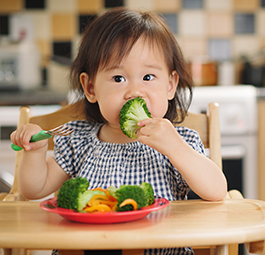What Is a Food Allergy

What Is a Food Allergy?
If your child has symptoms after eating certain foods, they may have a food allergy.
A food allergy occurs when the body’s immune system sees a certain food as harmful and reacts by causing symptoms. This is an allergic reaction. Foods that cause allergic reactions are allergens.

What Are the Two Types of Food Allergies?
There are two types, or categories, of food allergies:
- Immunoglobulin-E-mediated (IgE-mediated): With this type of food allergy, the body’s immune system makes antibodies called immunoglobulin E (IgE). IgE antibodies react with a certain food and causes symptoms.
- Non-IgE-mediated: Other parts of the body’s immune system react to a certain food. This reaction causes symptoms but does not involve IgE antibodies. Your child can have both IgE-mediated and non-IgE-mediated food allergies.
What Are IgE-Mediated Food Allergies?
The most common IgE-mediated food allergens are eggs, fish, milk, peanuts, sesame, shellfish, soy, tree nuts, and wheat. This type of allergic reaction can involve the skin, mouth, eyes, lungs, heart, gut, and brain.
IgE-mediated food allergy symptoms can include:
- Skin rash, itching, and hives
- Swelling of the lips, tongue, or throat
- Shortness of breath, trouble breathing, and wheezing (whistling sound during breathing)
- Stomach pain, vomiting, and diarrhea
- Feeling like something awful is about to happen
Food allergy symptoms occur shortly after the immune system comes into contact with an allergen. Some people may have a delay of two to three hours before symptoms first appear depending on the type of food allergy. IgE-mediated allergic reactions most often occur within minutes and up to 2 hours after eating the food allergen.
Sometimes food allergy symptoms are mild. Other times they can be severe. Take all allergic symptoms seriously. Mild and severe food allergy symptoms can lead to a serious allergic reaction called anaphylaxis [anna-fih-LACK-sis]. This reaction usually involves more than one part of the body and can get worse fast.
Anaphylaxis must be treated right away to provide the best chance for improvement and prevent serious, potentially life-threatening medical problems.
Epinephrine is the only first-line treatment for anaphylaxis. This medicine is safe and comes in an easy-to-use device called an auto-injector.
Antihistamines (such as BENADRYL® and ZYRTEC®) may not stop anaphylaxis. If your child is having a severe allergic reaction, use epinephrine first and immediately. But if you do not have epinephrine, an antihistamine is better than no treatment at all. If your child is having anaphylaxis and not responding to antihistamine or epinephrine, you should get medical help right away.
Cross-Reactivity to Other Foods and Pollen Food Allergy Syndrome
Having an IgE-mediated allergy to one food can mean your child is allergic to similar foods. The reaction between different foods is called cross-reactivity. This happens when proteins in one food are similar to the proteins in another food.
For example, if your child is allergic to shrimp, they may be allergic to other types of shellfish, such as crab or crayfish. Or if your child is allergic to cow’s milk, they may also be allergic to goat’s and sheep’s milk.
Cross-reactivity also can occur between latex and certain foods. For example, a child who has a latex allergy may also have an allergy to banana, avocado, kiwi, chestnut, or other foods.

People with pollen allergies can have allergic symptoms in and around the mouth and throat after eating raw fruits, vegetables, nuts, and seeds.
Some people who have allergies to the pollen of certain plants, such as ragweed and trees, may also react to some foods. This is called pollen food allergy syndrome (PFAS), also called oral allergy syndrome (OAS).
With PFAS, proteins in some pollen are similar to the proteins in some fruits and vegetables. So, if your child is allergic to ragweed, they may symptoms – such as an itchy mouth – to melon, banana, or other foods. That’s because their body thinks the protein in those foods looks like the proteins in ragweed pollen.
The most common symptoms of PFAS include an itchy mouth, throat, or tongue. Cooking the foods breaks down the proteins that cause the symptoms. Reactions usually occur only when someone eats raw food. In rare cases, PFAS reactions can cause anaphylaxis.
What Are Non-IgE-Mediated Food Allergies?
Most symptoms of non-IgE-mediated food allergies involve the digestive tract (gut). Symptoms may include vomiting and diarrhea. The symptoms can take longer to appear and may last longer than IgE-mediated allergy symptoms.
When your child has an allergic reaction with this type of allergy, you do not need to give epinephrine. But you still need to make sure your child doesn’t eat food that causes the reaction. Below are examples of conditions related to non-IgE-mediated food allergies.
Eosinophilic Esophagitis (EoE)
Eosinophilic esophagitis [EE-oh-sin-oh-FILL-ick uh-sof-uh-JIE-tis] is an allergic condition that causes an inflamed esophagus (swallowing tube). It is often called EoE for short. The esophagus is a tube that goes from your throat to your stomach. EoE occurs when a large number of white blood cells called eosinophils [EE-oh-sin-oh-FILLS] collect and damage the lining of the esophagus. In many people, it may be related to an immune response to food. If so, they have to remove certain foods from their diet to treat EoE. Sometimes other allergens, such as pollen, can trigger EoE.
Food Protein-Induced Enterocolitis Syndrome (FPIES)
Food protein-induced enterocolitis syndrome (FPIES) is another type of food allergy. It most often affects young infants. Symptoms usually don’t appear for two or more hours after eating.
Once the infant stops eating the food causing the allergy, the symptoms go away. Vomiting and diarrhea are the most common symptoms. Severe vomiting and diarrhea can occur which can lead to dehydration and even shock. Shock occurs when the body is not getting enough blood flow. Emergency treatment, such as intravenous (IV) fluids, for severe symptoms must occur right away at a hospital. The foods most likely to cause an FPIES reaction are dairy, soy, rice, oat, barley, green beans, peas, sweet potatoes, squash, and poultry.
Allergic Proctocolitis
Allergic proctocolitis is most often an allergy to cow’s milk or soy proteins found in formula or human milk. This condition inflames the lower part of the intestine. It affects infants in their first year of life and usually ends by age 1.
The symptoms include blood-streaked, watery, and mucus-filled stools. Infants may also develop green stools, diarrhea, vomiting, anemia (low iron in the blood), and fussiness. When properly diagnosed, symptoms resolve once the foods the child is reacting to are removed from their diet.
Not all children who react to a certain food have an allergy. They may have a food intolerance. Examples are lactose intolerance, gluten intolerance, or sulfite sensitivity.
If your child has any symptoms after eating certain foods, see your child’s doctor or allergist, as you do not want to have to remove food from your child’s diet unnecessarily, as this could affect their nutrition. Only a doctor can properly diagnose whether your child has an IgE- or non-IgE food allergy. Both can be present in some children. Also consider seeing a dietitian if your child needs to eliminate food from their diet to ensure they are avoiding foods appropriately and getting proper nutrition.
Medical review: May 2024 by David Fleischer, MD













